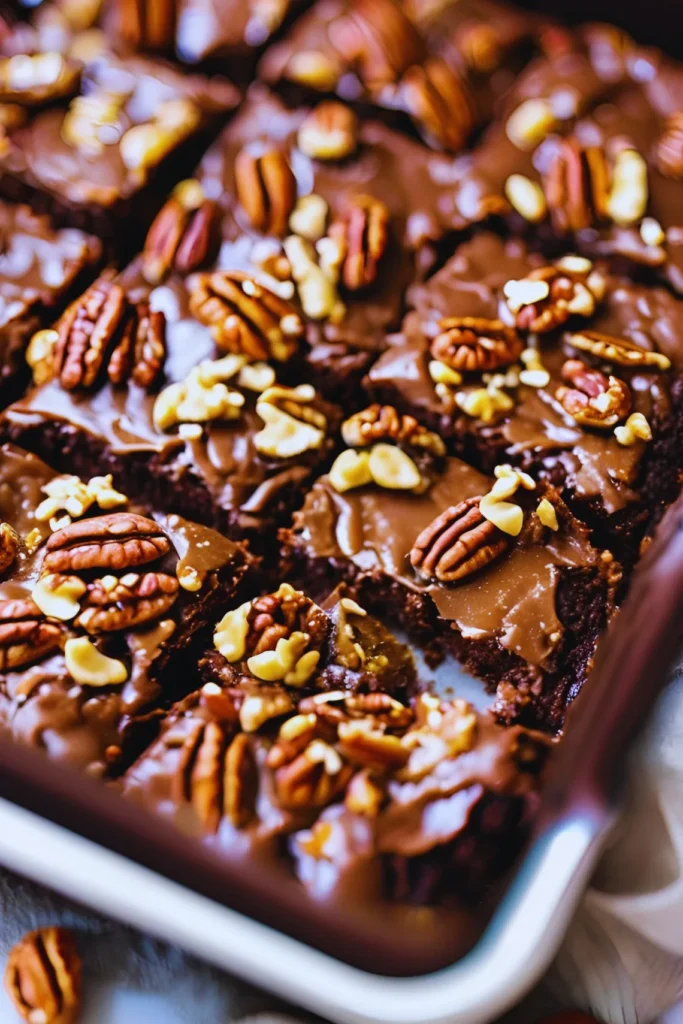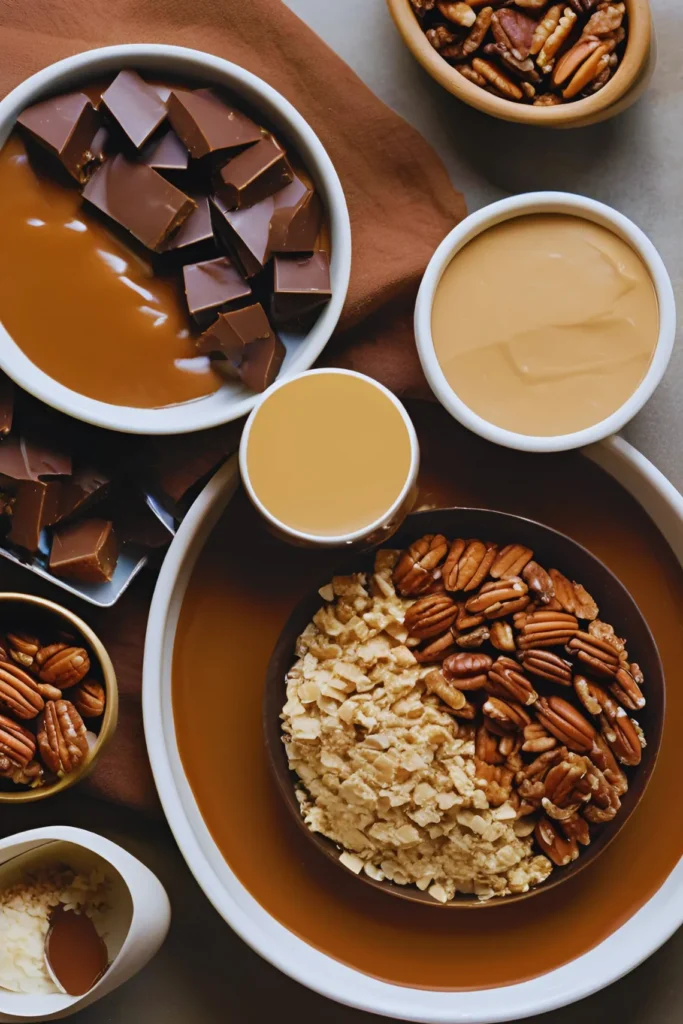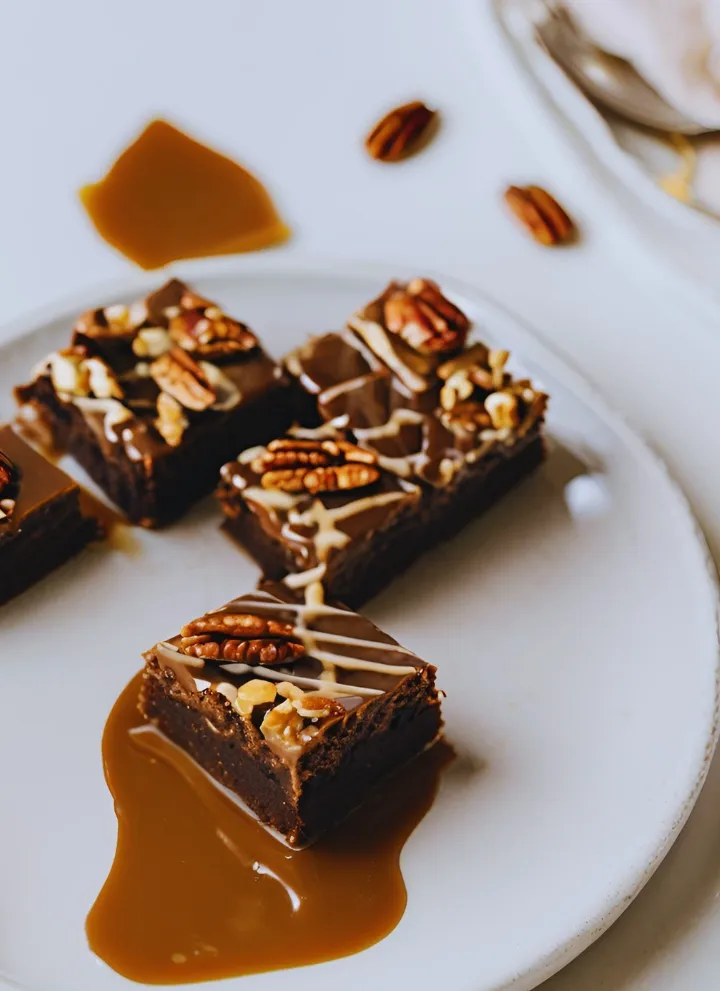Exploring the Name and Popularity of Turtle Brownies
Turtle brownies are a decadent dessert that has captured the hearts of many dessert enthusiasts. With their rich combination of chocolate, caramel, and pecans, these brownies bring together a medley of flavors and textures that cater to every sweet tooth. But why are they called “turtle brownies,” and what makes them such a favorite?
What Are Turtle Brownies?
A Detailed Definition of Turtle Brownies
At their core, turtle brownies are a chocolate dessert that incorporates the key ingredients of chocolate, caramel, and pecans. These elements come together to form a dessert that is not only gooey and indulgent but also visually appealing.
- Chocolate provides the base and richness.
- Caramel offers a sticky sweetness that oozes with every bite.
- Pecans add a satisfying crunch and a nutty undertone.
Turtle brownies are typically baked in layers, with chocolate as the foundation, caramel and pecans in the middle, and more chocolate drizzled on top for a show-stopping finish.
Why the Name “Turtle”?
An Explanation of the Turtle Reference in Desserts
The name “turtle” may seem unusual at first glance, but it has a delightful backstory tied to turtle-shaped candies. These candies, which date back to the early 20th century, inspired the naming of turtle brownies and other turtle-themed desserts.
Connection to Turtle Candies
How Turtle Brownies Are Inspired by Turtle-Shaped Candies
The origin of the name traces back to turtle candies, which were created by placing pecans in clusters and covering them with caramel and chocolate. The shape of these candies resembled a turtle, with the pecans mimicking legs and the chocolate-covered caramel forming the shell. Over time, the “turtle” concept expanded to include other desserts featuring the same flavor profile.
History of Turtle Desserts
Tracing the Roots of Turtle Brownies in Baking
Turtle brownies are part of a larger category of turtle desserts, which gained popularity in the mid-20th century. As turtle candies became a beloved confection, bakers began incorporating their flavors into cakes, pies, and eventually brownies. The introduction of these desserts into mainstream baking marked the beginning of their widespread appeal.

Role of Pecans, Caramel, and Chocolate
How Classic Ingredients Influence the Name
The signature trio of pecans, caramel, and chocolate is essential to what makes a dessert “turtle.” Each ingredient contributes:
- Pecans add texture and a nutty flavor that balances the sweetness.
- Caramel provides a gooey, luxurious element.
- Chocolate ties the flavors together with its richness.
Without these elements, the dessert would lose its “turtle” identity.
Comparison with Other Turtle Recipes
Similarities Between Turtle Brownies, Cake, and Pie
Turtle brownies share a common flavor profile with other turtle-inspired desserts like turtle cake and turtle pie. The main differences lie in texture and preparation:
- Turtle cakes are layered with sponge cake, caramel, and pecans.
- Turtle pies often use a graham cracker crust with a creamy caramel filling.
- Turtle brownies distinguish themselves with their fudgy chocolate base.
Despite these differences, all these desserts evoke the comforting, indulgent flavors associated with turtle candies.
Explore how different desserts like rocky road cookies achieve this balance of sweetness and texture for more ideas.
Origins of Turtle Candy
A Brief History of the Candy That Started It All
Turtle candies were invented in the early 1900s by the DeMet’s Candy Company. Their unique shape and irresistible combination of chocolate, caramel, and pecans quickly gained popularity. The candy’s name came about when a customer remarked that the treat resembled a turtle, a name that stuck and became iconic.
How “Turtle” Became Synonymous with Rich Desserts
Cultural Influence on the Naming Trend
The term “turtle” evolved to represent any dessert with the same indulgent flavor profile. Over time, it became synonymous with luxury and comfort. This cultural association has made turtle brownies a staple in bakeries and households alike, cementing their place in dessert history.
The Essential Ingredients of Turtle Brownies
What Goes Into Making Turtle Brownies
Creating turtle brownies is an art, combining the perfect balance of rich flavors and textures. These brownies rely on a few key ingredients to achieve their signature taste, each playing a vital role in the overall experience. Let’s delve deeper into what makes these ingredients essential.

Chocolate as the Base
Types of Chocolate Used in Turtle Brownies
Chocolate is the heart of turtle brownies, providing the rich and fudgy foundation that supports the other flavors. The type of chocolate used can vary, each bringing unique qualities:
- Dark Chocolate: Offers a slightly bitter note that balances the sweetness of caramel.
- Milk Chocolate: Provides a creamy, sweet base for a more indulgent flavor.
- Semi-Sweet Chocolate Chips: Often added as mix-ins for bursts of chocolate in every bite.
The choice of chocolate greatly impacts the brownie’s depth of flavor. For a more gourmet touch, high-quality couverture chocolate is an excellent choice.
Caramel’s Sticky Sweetness
The Role of Caramel in Creating the Turtle Effect
Caramel is the showstopper in turtle brownies, creating the gooey texture that defines this dessert. It is typically incorporated in two ways:
- Layered Caramel: A ribbon of caramel is added between the brownie batter, ensuring a rich and sticky middle.
- Drizzled Caramel: Added on top as a finishing touch, it enhances the visual appeal and adds another layer of sweetness.
To achieve the best results, homemade caramel is often preferred for its fresh, buttery taste. Store-bought caramel sauces, however, can work as a convenient alternative.
Pecans as a Signature Ingredient
Why Pecans Are Integral to Turtle Brownies
Pecans are the signature nut in turtle brownies, adding crunch and a nutty flavor that complements the sweetness of chocolate and caramel. Their inclusion serves both a textural and flavor-enhancing purpose:
- Texture: Pecans break up the gooeyness with a satisfying crunch.
- Flavor: Their earthy, buttery taste balances the richness of the other ingredients.
Some bakers lightly toast the pecans before adding them, intensifying their natural flavors and bringing out a deeper nuttiness.
Combining Flavors and Textures
Balancing Sweetness, Crunch, and Gooeyness
The magic of turtle brownies lies in their ability to balance multiple textures and flavors:
- Sweetness: Comes from the caramel and chocolate, creating an indulgent dessert.
- Crunch: Provided by pecans, which add variety to the texture.
- Gooeyness: Achieved through the caramel and fudgy brownie base.
Achieving this balance requires careful layering and the right proportions of each ingredient.
Baking Methods for Turtle Brownies
Step-by-Step Guide to Preparing Turtle Brownies
- Prepare the Brownie Batter: Mix melted chocolate, butter, sugar, eggs, and flour to create a rich batter.
- Layer the Ingredients:
- Pour half the batter into the baking dish.
- Add a layer of caramel and sprinkle with chopped pecans.
- Top with the remaining brownie batter.
- Bake: Bake at 350°F (175°C) until the edges are set but the center remains slightly gooey.
- Add Finishing Touches:
- Drizzle more caramel on top.
- Sprinkle additional pecans and, optionally, chocolate chips.
Allow the brownies to cool completely before cutting for clean slices and optimal texture.
Variations of Turtle Brownies
Unique Twists on the Classic Recipe
While traditional turtle brownies are hard to beat, there are several variations to suit different preferences:
- Salted Caramel Turtle Brownies: A sprinkle of sea salt enhances the caramel’s flavor.
- Turtle Cheesecake Brownies: A layer of cheesecake adds creaminess to the dessert.
- Peanut Butter Turtle Brownies: Replacing some caramel with peanut butter offers a nutty twist.
These variations keep the essence of turtle brownies while introducing exciting new elements.
Vegan and Gluten-Free Options
Adapting the Recipe for Dietary Restrictions
Turtle brownies can easily be modified for those with dietary restrictions:
- Vegan:
- Use plant-based butter and almond milk for the brownie batter.
- Replace eggs with flaxseed or applesauce.
- Opt for vegan chocolate and caramel.
- Gluten-Free:
- Substitute regular flour with almond flour or a gluten-free baking blend.
- Ensure all other ingredients, such as chocolate and caramel, are gluten-free.
These adaptations ensure that everyone can enjoy the indulgent flavors of turtle brownies.
Common Mistakes to Avoid
Tips for Perfectly Gooey and Crunchy Brownies
Even with the best ingredients, mistakes can happen. Here are some common pitfalls and how to avoid them:
- Overbaking: Leads to dry brownies. Remove them from the oven when the center is slightly undercooked.
- Uneven Layering: Results in some bites lacking caramel or pecans. Spread the layers evenly for consistent flavor.
- Skipping Cooling Time: Cutting the brownies too soon causes them to fall apart. Allow them to cool completely for clean cuts.
By avoiding these mistakes, you can achieve perfectly gooey and crunchy turtle brownies every time.
Turtle Brownies in Modern Culture
Why They’re a Dessert Staple Today
Turtle brownies have become a staple in modern dessert culture thanks to their universal appeal. Their combination of rich chocolate, gooey caramel, and crunchy pecans offers something for everyone, whether you’re a chocolate lover, a caramel enthusiast, or a fan of nutty flavors. Beyond their irresistible taste, turtle brownies symbolize indulgence and comfort, making them a popular choice for a variety of occasions.
Popularity in the U.S.
Turtle Brownies’ Place in American Dessert Culture
In the U.S., turtle brownies are a quintessential dessert found in bakeries, restaurants, and homes alike. Their popularity stems from several factors:
- Comfort Food Appeal: Turtle brownies are the epitome of comfort food, with their warm, gooey texture and nostalgic flavors.
- Versatility: Whether served as a simple snack or dressed up for a formal dessert, they fit seamlessly into any occasion.
- Cultural Influence: Americans have long embraced turtle desserts, starting with turtle candies, making brownies a natural evolution of this trend.
The widespread availability of pre-made turtle brownies and mixes has further cemented their status as a beloved dessert across the nation.
Serving Ideas and Pairings
How to Enjoy Turtle Brownies to the Fullest
While turtle brownies are delicious on their own, they can be elevated with thoughtful pairings:
- With Ice Cream: Serve warm brownies with a scoop of vanilla or caramel ice cream for an indulgent dessert.
- Drinks:
- Pair with a glass of milk for a classic combination.
- For adults, enjoy with a cup of coffee or a glass of port wine to complement the richness.
- Toppings:
- Whipped cream and a drizzle of caramel sauce add a luxurious touch.
- Sprinkle with sea salt for a sophisticated flavor contrast.
These serving ideas make turtle brownies suitable for casual evenings or as the highlight of a dinner party dessert menu.

Occasions to Serve Turtle Brownies
From Birthdays to Casual Snacks
Turtle brownies are versatile enough to suit any event, from celebratory gatherings to simple snacks:
- Special Occasions: Perfect for birthdays, anniversaries, and holidays like Thanksgiving or Christmas.
- Potlucks and Parties: Their rich flavor and visually appealing layers make them a hit at communal events.
- Everyday Indulgence: For a quick treat, turtle brownies satisfy cravings without needing a special reason.
Their adaptability ensures they remain a go-to dessert for a wide range of settings.
Turtle Brownies vs. Other Desserts
How They Stand Out Among Sweet Treats
While other desserts may share similar flavors, turtle brownies stand out due to their unique combination of gooeyness, crunch, and richness. Here’s how they compare:
- Brownies: Traditional brownies lack the caramel and pecans that make turtle brownies distinctive.
- Cakes: While cakes offer a softer texture, they don’t provide the dense, fudgy base characteristic of turtle brownies.
- Pies: Turtle pies may share similar ingredients but lack the handheld convenience of brownies.
This versatility and uniqueness make turtle brownies a favorite among dessert lovers.
Dessert Trends Featuring Turtle Brownies
Unique Incorporations of Turtle Brownies in Menus
As culinary creativity continues to evolve, turtle brownies have inspired new dessert trends:
- Turtle Brownie Sundaes: Layers of brownie chunks, caramel, pecans, and ice cream create a decadent dessert parfait.
- Turtle Brownie Milkshakes: Blending pieces of turtle brownie with vanilla ice cream and milk results in a rich, drinkable dessert.
- Turtle Brownie Cupcakes: Individual portions with a brownie base, caramel filling, and pecan topping add a twist to the classic dessert.
These trends highlight the adaptability of turtle brownies and their ability to inspire innovation.
Turtle Brownies Around the World
Global Takes on This Classic Dessert
While turtle brownies are predominantly an American creation, their influence can be seen in desserts worldwide:
- Europe: Similar rich, layered desserts featuring caramel and nuts are popular, such as pecan tarts or caramel-drizzled cakes.
- Asia: Ingredients like salted caramel and chocolate are often adapted into pastries, providing a lighter interpretation of turtle brownies.
- South America: Dulce de leche, a caramel-like spread, is used in brownies, offering a regional twist.
These global variations showcase the universal appeal of the flavors found in turtle brownies.
Nostalgia Associated with Turtle Brownies
Why People Love Their Familiar Flavors
Turtle brownies evoke a sense of nostalgia for many people, bringing back memories of childhood treats or family gatherings. The flavors of chocolate, caramel, and pecans are universally comforting, reminding people of:
- Homemade Desserts: Many grew up enjoying turtle brownies baked by family members.
- Holiday Traditions: Turtle brownies are often associated with festive occasions and shared moments.
This emotional connection contributes to their enduring popularity.
Turtle Brownies in Baking Competitions
Their Role in Showcasing Baking Skills
In baking competitions, turtle brownies are a popular choice for showcasing creativity and technical skill. Bakers often elevate the classic recipe with intricate techniques:
- Homemade Caramel: Demonstrates precision and timing in achieving the perfect consistency.
- Decorative Toppings: Adds visual appeal through artistic drizzles or pecan arrangements.
- Flavor Innovations: Incorporates unique ingredients like bourbon caramel or chili-infused chocolate.
These elements allow bakers to highlight their talents while honoring the classic flavors of turtle brownies.
FAQs About Turtle Brownies
1. What is the best type of caramel for turtle brownies?
Homemade caramel is often the best choice for turtle brownies because it offers a fresh, buttery flavor and the right consistency. However, if you’re short on time, high-quality store-bought caramel works just as well. Whichever you choose, ensure the caramel remains pourable but thick enough to avoid sinking into the batter. Additionally, warming the caramel slightly before use can help it spread more evenly.
2. Can I use a boxed brownie mix to make turtle brownies?
Yes, boxed brownie mix can serve as a quick and convenient base for turtle brownies. To enhance the flavor, you can mix in extra chocolate chips or a splash of vanilla extract. Once the batter is ready, follow the traditional layering method with caramel and pecans. Using a mix saves time without compromising the dessert’s signature turtle flavor profile.
3. How can I prevent the caramel from sticking to the knife when cutting the brownies?
To avoid sticky caramel ruining your slices, try cooling the brownies completely before cutting them. Using a sharp knife dipped in warm water between cuts also ensures clean edges. Moreover, wiping the blade after each slice removes any build-up, allowing for smooth and neat brownie pieces.
4. Are there other nuts I can use besides pecans?
Absolutely! While pecans are traditional, walnuts, almonds, or hazelnuts can provide a unique twist on the classic recipe. Each nut brings its own texture and flavor, so you can experiment to find what suits your taste. Toasting the nuts beforehand can enhance their flavor, making them a delightful addition to your turtle brownies.
5. What’s the ideal serving temperature for turtle brownies?
Turtle brownies are delicious at room temperature, but serving them slightly warm can elevate their gooey texture and enhance the flavors. To warm them, microwave individual slices for 10-15 seconds. Pairing them with a scoop of ice cream or a drizzle of warm caramel sauce adds an extra layer of indulgence.
6. Can I make turtle brownies healthier without losing their rich taste?
Yes, you can make healthier substitutions without sacrificing too much of their richness. For instance, replace some butter with applesauce, use dark chocolate instead of milk chocolate, and opt for natural sweeteners like maple syrup. Additionally, using whole wheat or almond flour can add fiber while keeping the brownies moist and delicious.
7. Why do my turtle brownies sometimes turn out dry?
Dry turtle brownies often result from overbaking or incorrect ingredient measurements. To avoid this, keep a close eye on the baking time and remove the brownies when the center is slightly undercooked. Moreover, using high-quality chocolate and caramel ensures the dessert retains its moisture and richness. If needed, a small drizzle of extra caramel after baking can also help revive dry brownies.


